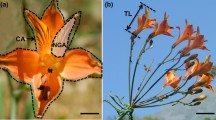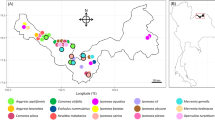Abstract
Dactylorhiza sambucina is a European terrestrial orchid that lacks a pollinator reward. Throughout most of its range, populations contain yellow- and purple-flowering individuals, but in western Germany, monomorphic yellow populations predominate. As elsewhere, bumblebee queens are the most important pollinators in these populations, and mean fruit set over two years was 19%, well within the range reported from dimorphic populations. Multivariate analyses of plant and population traits, including plant height, leaf number, flower number and density on the spikes, flowering population density, and nearest neighbor distance, showed that only individual plant height and population density had a unique positive effect on pollen export; female function was unrelated to height or population density. The positive effects of dense spacing of flowering conspecifics and tall size appear due to greater visual attractiveness. Good visual exposure may also explain that flowers higher up on the spikes, in spite of opening late in the season, had higher male reproductive success than early flowers.
Similar content being viewed by others
Author information
Authors and Affiliations
Corresponding author
Rights and permissions
About this article
Cite this article
Kropf, M., Renner, S.S. Pollination success in monochromic yellow populations of the rewardless orchid Dactylorhiza sambucina. Plant Syst. Evol. 254, 185–197 (2005). https://doi.org/10.1007/s00606-005-0338-0
Received:
Accepted:
Published:
Issue Date:
DOI: https://doi.org/10.1007/s00606-005-0338-0




